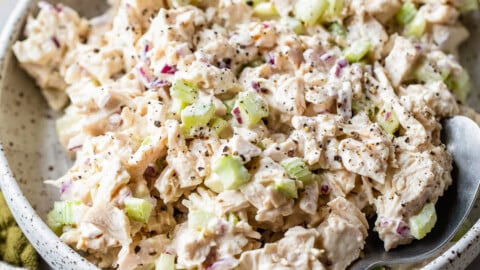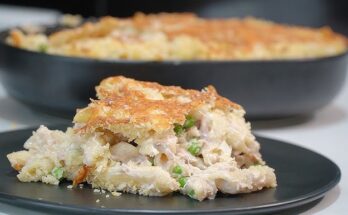Classic Chicken Salad Recipe: There’s something comforting about a bowl of classic chicken salad. It’s creamy, flavorful, and versatile enough to enjoy in so many ways—whether stuffed in a sandwich, served over greens, or scooped up with crackers. If you’ve been craving a hearty yet refreshing dish that’s quick to put together, this chicken salad recipe is exactly what you need. With simple ingredients and easy steps, you can make it ahead for busy weekdays, picnics, or even potlucks. Let’s dive into this step-by-step guide so you can create the perfect chicken salad at home.
Introduction to Classic Chicken Salad
Chicken salad has earned its reputation as a timeless recipe because it strikes the perfect balance between comfort food and fresh flavor. For decades, it has been a go-to dish for gatherings, family meals, and even meal prepping. The beauty of chicken salad lies in its versatility—you can keep it traditional with chicken, mayo, and celery, or jazz it up with fruits, nuts, and spices.
One of the best things about chicken salad is how effortlessly it fits into different occasions. Need a quick weekday lunch? Spread it between slices of bread for a hearty sandwich. Hosting a brunch? Serve it in croissants or lettuce cups. Preparing for a picnic? Pack it with crackers for an easy finger food option. No matter the occasion, chicken salad brings both flavor and convenience to the table.
But what truly sets a classic chicken salad apart is the perfect blend of tender chicken, crunchy vegetables, creamy dressing, and a hint of tangy seasoning. When these components come together, you get a dish that feels both rich and refreshing. Whether you’re an experienced cook or just starting in the kitchen, this recipe will quickly become one of your staples.
Ingredients You’ll Need
Before we jump into the preparation, let’s gather the essential ingredients that make this salad irresistible. While chicken is obviously the star of the dish, the supporting ingredients play just as big of a role in creating layers of texture and flavor.
Essential Ingredients:
- Chicken – 2 to 3 cups, cooked and shredded (grilled, roasted, or poached work well)
- Celery – 2 stalks, finely chopped for a crisp bite
- Red onion – ¼ cup, diced for a mild sharpness
- Grapes or apples – 1 cup, chopped for sweetness (optional but recommended)
- Mayonnaise – ½ to ¾ cup, for creaminess
- Mustard – 1 tablespoon, for tanginess
- Lemon juice – 1 tablespoon, to brighten flavors
- Salt and pepper – to taste
Optional Add-Ons:
- Chopped nuts – like almonds or pecans for crunch
- Fresh herbs – parsley, dill, or chives for extra freshness
- Cheese – a sprinkle of feta or shredded cheddar if you like it richer
The flexibility of chicken salad allows you to adjust these ingredients based on your taste. If you prefer it sweeter, add more grapes or apples. Want it tangier? Increase the lemon juice or mustard. More of a crunch fan? Toss in extra celery or nuts. The possibilities are endless.
Choosing the Right Chicken for Salad
The type of chicken you use makes a huge difference in the final taste and texture of your salad. Since chicken is the star ingredient, picking the right cut and cooking method is crucial.
Best Cuts for Chicken Salad:
- Chicken breast – Lean, mild, and shreds beautifully. Ideal if you want a lighter salad.
- Chicken thighs – Juicier and more flavorful, perfect for a richer salad.
- Rotisserie chicken – A convenient option if you’re short on time.
Cooking Tips for Tender Chicken:
- Poaching – Simmer chicken breasts in seasoned water or broth until tender. This method keeps the meat moist and easy to shred.
- Grilling – Adds a smoky flavor, which gives the salad an extra depth. Just don’t overcook, or the chicken may dry out.
- Roasting – Locks in flavor and works well if you’re cooking chicken in bulk.
The key is to cook your chicken just right—not too dry, not underdone. Once cooked, let it rest before shredding or dicing. Resting helps retain juices, keeping your salad moist and flavorful. If you want to save time, using leftover chicken from another meal or a store-bought rotisserie chicken works just fine.
Fresh Vegetables and Fruits for Added Crunch
What makes chicken salad more exciting is the addition of crunchy vegetables and refreshing fruits. Without them, the dish can feel too heavy and one-dimensional. Think of these ingredients as the “personality” of your salad—they add color, crunch, and a touch of sweetness or tartness.
Classic Veggies to Use:
- Celery – Crisp and refreshing, celery is a must-have.
- Red onion – Adds a subtle kick without overpowering.
- Bell peppers – For extra crunch and a splash of color.
Fruits for a Flavor Boost:
- Red grapes – Sweet and juicy, perfect balance to the savory chicken.
- Apples – A tart, crisp alternative to grapes.
- Dried cranberries – Chewy texture and tangy-sweet flavor.
The trick is to chop everything into bite-sized pieces so each forkful has a little bit of everything. Fruits like grapes and apples are best added last to prevent them from browning or softening too quickly. When balanced properly, the combination of chicken, vegetables, and fruit creates a salad that’s not only filling but also refreshing and satisfying.
Dressings and Seasonings
If the chicken and vegetables form the body of this recipe, then the dressing is the soul. It’s what binds everything together, transforming simple ingredients into a creamy, flavorful salad. A great chicken salad dressing is all about balance—creamy yet not too heavy, tangy yet not overpowering. Let’s break down how to create the perfect mix.
Classic Dressing Base
The most traditional chicken salad dressing relies on mayonnaise. It gives the salad that rich, smooth texture that most of us love. But mayo alone can feel a little flat, which is why a splash of acidity—like lemon juice or vinegar—is essential. The acid brightens the flavors and prevents the salad from tasting too heavy.
Key Ingredients for the Dressing
- Mayonnaise – Creamy base that coats the chicken and veggies.
- Dijon mustard – Adds a subtle tang and depth of flavor.
- Lemon juice – A squeeze of fresh juice balances the creaminess with freshness.
- Salt and pepper – Simple seasonings that bring everything to life.
Healthier Alternatives
If you’re looking to lighten things up, you don’t have to rely solely on mayonnaise. Try these substitutions:
- Greek yogurt – Creamy with a hint of tang, and packed with protein.
- Avocado – Mashed avocado gives a rich texture with healthy fats.
- Light mayo – Lower in calories while still providing creaminess.
A great trick is to combine Greek yogurt with mayo for the best of both worlds—creamy and tangy but lighter than using all mayo. Play around with seasonings, too. Fresh herbs like dill, parsley, or chives bring a burst of freshness, while a pinch of garlic powder or paprika can give it a little kick. The goal is to make a dressing that complements the chicken rather than overwhelming it.
Step-by-Step Guide to Making Chicken Salad
Now that we’ve covered the essentials, let’s get into the step-by-step process of making the best chicken salad at home. The beauty of this recipe is how simple it is—no complicated techniques, just a few easy steps.
Step 1: Prepare the Chicken
Start by cooking your chicken. If using raw chicken breasts or thighs, you can poach, roast, or grill them until fully cooked. Allow them to cool slightly before shredding or dicing into bite-sized pieces. If you’re using rotisserie or leftover chicken, just remove the skin and bones, then chop the meat.
Step 2: Chop the Vegetables and Fruits
Next, prepare your add-ins. Dice celery and onions finely so they distribute evenly without overwhelming a bite. Slice grapes in half or chop apples into small cubes. This ensures you get a perfect balance of flavors in every forkful.
Step 3: Mix the Dressing
In a small bowl, whisk together mayonnaise, mustard, lemon juice, salt, and pepper. Taste as you go and adjust seasoning to your liking. If you want to experiment, add a sprinkle of paprika or some fresh herbs for extra flavor.
Step 4: Combine Ingredients
In a large mixing bowl, add the shredded chicken, chopped vegetables, and fruits. Pour the dressing over everything and gently mix until all ingredients are evenly coated. Be careful not to mash the ingredients—gentle folding keeps the texture intact.
Step 5: Chill Before Serving
This is the secret step many people skip. Once mixed, cover your chicken salad and refrigerate it for at least 30 minutes before serving. This chilling time allows the flavors to meld together, making the salad taste even better.
And just like that, you have a bowl of creamy, refreshing chicken salad ready to serve.
Preparing the Chicken Perfectly
Since chicken is the star of the recipe, let’s take a closer look at how to prepare it properly. The difference between a bland salad and an unforgettable one often comes down to how you cook your chicken.
Poaching Method
Poaching is one of the most popular ways to prepare chicken for salad because it keeps the meat moist. Place chicken breasts in a pot, cover with water or broth, add a pinch of salt and optional aromatics (like garlic, onion, or bay leaves), then simmer gently for 15–20 minutes. Once cooked, let it rest before shredding.
Roasting Method
If you want a slightly deeper flavor, roasting is the way to go. Preheat your oven to 400°F (200°C). Rub chicken breasts or thighs with olive oil, salt, and pepper, then roast for about 20–25 minutes. Let them cool before chopping. The roasted flavor adds a subtle richness to your salad.
Grilling Method
Grilling gives chicken a smoky, charred flavor that pairs beautifully with the creamy dressing. Simply season your chicken with salt, pepper, and a bit of olive oil, then grill for 5–7 minutes per side until fully cooked. Allow it to cool, then dice or shred.
Shredding vs. Dicing
- Shredded chicken – Softer texture, blends seamlessly with the dressing.
- Diced chicken – Keeps its shape and offers a chunkier bite.
Both work well—it really depends on whether you like your chicken salad smooth and creamy or chunky and hearty.
Mixing the Dressing
Now that your chicken is cooked and your veggies are prepped, it’s time to bring everything together with the dressing. Think of this step as creating the “glue” that binds all the flavors. A good dressing doesn’t just coat the ingredients—it elevates them, balancing creaminess with just the right amount of tang.
Classic Mayo-Based Dressing
The tried-and-true version starts with mayonnaise as the base. Its creamy texture makes the salad rich and smooth. To keep things interesting, we add Dijon mustard for a subtle zing, lemon juice for brightness, and a dash of salt and pepper for seasoning. This blend creates a perfectly balanced dressing that pairs beautifully with tender chicken and crisp veggies.
Basic Dressing Recipe:
- ¾ cup mayonnaise
- 1 tablespoon Dijon mustard
- 1 tablespoon lemon juice (freshly squeezed)
- ½ teaspoon salt
- ¼ teaspoon black pepper
Simply whisk these ingredients together in a small bowl until smooth. Taste, then adjust the seasonings as needed.
Healthier Variations
If you want to cut down on calories without sacrificing taste, swap part of the mayo with:
- Greek yogurt – Adds protein and a light tang.
- Mashed avocado – Provides creaminess and healthy fats.
- Olive oil-based mayo – A lighter version of the classic.
Mixing half Greek yogurt and half mayo is a popular choice—it keeps the familiar taste but feels lighter and fresher.
Flavor Boosters
Want to make your chicken salad dressing more exciting? Add a pinch of garlic powder, paprika, or cayenne for spice. Fresh herbs like dill, parsley, or basil also work wonders. A drizzle of honey can balance out the tang, while a splash of vinegar (like apple cider or white wine vinegar) sharpens the flavor profile.
The key is balance—you don’t want the dressing to overpower the ingredients, just complement them.
Combining Ingredients for the Perfect Salad
Once your dressing is ready, it’s time to combine everything. This step might seem simple, but a few techniques can make the difference between a soggy mess and a crisp, delicious salad.
Step 1: Start with the Chicken
Place your shredded or diced chicken in a large mixing bowl. This gives you enough room to fold everything together without spilling.
Step 2: Add the Vegetables and Fruits
Toss in your celery, onion, and any fruits like grapes or apples. Adding them before the dressing ensures they get evenly distributed throughout the chicken.
Step 3: Fold in the Dressing
Pour your prepared dressing over the chicken mixture. Instead of stirring vigorously, gently fold the ingredients together. This keeps the chicken pieces intact and preserves the crunch of the vegetables.
Step 4: Taste and Adjust
Once mixed, take a spoonful to taste. If it feels too dry, add an extra spoon of mayo or yogurt. If it needs more brightness, squeeze in a bit more lemon juice. Adjust salt and pepper until it’s just right.
Step 5: Chill for Best Flavor
Cover the bowl with plastic wrap or transfer the salad to an airtight container. Refrigerate for at least 30 minutes before serving. This step allows the flavors to blend and deepen, making the salad even more delicious.
Pro tip: If you’re adding nuts (like almonds or pecans), sprinkle them in just before serving so they stay crunchy.
Serving Suggestions
One of the best things about chicken salad is how versatile it is. You can serve it in so many ways depending on the occasion—whether it’s a casual weekday lunch, a picnic, or even a party appetizer.
Classic Sandwiches
Spread chicken salad between two slices of fresh bread for a quick and filling meal. Croissants make an indulgent choice, while whole-grain bread gives a healthier twist. Add lettuce leaves or tomato slices for extra freshness.
Lettuce Wraps
For a low-carb option, scoop chicken salad into large lettuce leaves (like romaine or butter lettuce). It’s crunchy, refreshing, and perfect if you’re watching carbs.
On Crackers
Serve chicken salad as a dip with crackers or toasted baguette slices. This works wonderfully as a party appetizer or snack.
Over Greens
Turn chicken salad into a full meal by serving it over a bed of mixed greens. Add sliced cucumbers, cherry tomatoes, and a drizzle of olive oil for a refreshing salad bowl.
Stuffed Veggies
For something unique, try stuffing chicken salad into hollowed-out tomatoes, bell peppers, or even avocados. Not only is it visually appealing, but it also makes for a fun presentation at gatherings.
With Sides
Pair your chicken salad with light sides like fruit salad, potato chips, or a bowl of soup. It makes a complete meal that feels comforting and satisfying.
The beauty of chicken salad is that it adapts to your needs—whether you want a light snack, a hearty meal, or an elegant dish for entertaining, this recipe has you covered.
Storage and Make-Ahead Tips
Chicken salad is one of those dishes that tastes even better the next day, making it perfect for meal prep. But storage matters—you don’t want your salad turning soggy or losing flavor.
Refrigeration
Store chicken salad in an airtight container in the refrigerator. It stays fresh for about 3 to 4 days. Make sure it’s chilled properly, especially if you added ingredients like mayo or yogurt, which are perishable.
Freezing (Not Recommended)
While technically you can freeze chicken salad, it’s not ideal. Mayo and yogurt tend to separate after thawing, which makes the texture watery and unappealing. If you must freeze it, consider leaving out the dressing and adding it fresh once thawed.
Make-Ahead Tips
- Cook the chicken in advance – Poach, roast, or grill chicken ahead of time and store it in the fridge for up to 2 days before making the salad.
- Prep veggies separately – Chop celery, onions, and fruits but keep them stored in separate containers until you’re ready to assemble.
- Add nuts last – To maintain crunch, stir in nuts right before serving.
With these tips, you can easily prepare chicken salad ahead of time for lunches, parties, or busy weekdays without losing flavor or texture.
Variations of Classic Chicken Salad
One of the best things about chicken salad is how adaptable it is. While the classic version never disappoints, there are countless ways to tweak the recipe to match your personal taste or dietary needs. Whether you prefer spicy, fruity, or globally inspired flavors, there’s a chicken salad variation for you.
Curried Chicken Salad
Add a teaspoon or two of curry powder to the dressing for a warm, earthy flavor. Toss in golden raisins or dried cranberries for sweetness, and top with chopped cashews or almonds for crunch. This version is bold, colorful, and full of character.
Mediterranean-Style Chicken Salad
Swap out mayonnaise for Greek yogurt and olive oil. Mix in chopped cucumbers, tomatoes, olives, and feta cheese. Season with oregano and a splash of red wine vinegar. The result is a refreshing, zesty salad that feels like a trip to the Mediterranean.
Spicy Chicken Salad
If you love a little heat, add diced jalapeños or a dash of cayenne pepper to your dressing. You can also stir in hot sauce or sriracha for extra kick. This spicy variation pairs perfectly with lettuce wraps or tortilla chips.
Fruity Chicken Salad
Want something light and refreshing? Add diced apples, pineapple chunks, or mandarin oranges. The sweetness of the fruit balances the savory chicken beautifully, making this version great for summer picnics.
Herb-Loaded Chicken Salad
For a garden-fresh twist, load your salad with herbs like parsley, dill, cilantro, or basil. The burst of greenery makes it taste bright and vibrant without needing too many add-ins.
The variations are endless—you can even combine ideas, like a spicy curried chicken salad or a fruity Mediterranean one. Don’t be afraid to experiment until you find your perfect blend.
Nutritional Value of Chicken Salad
Chicken salad isn’t just tasty—it’s also packed with nutrients, especially when made with wholesome ingredients. While the exact nutrition depends on the recipe, here’s a general breakdown of what you’re getting from a classic chicken salad.
Macronutrients
- Protein: Chicken is a lean source of protein, essential for muscle repair and keeping you full. A serving typically provides 20–25 grams of protein.
- Fats: Mayonnaise contributes fats, which can be higher in calories. Using Greek yogurt or avocado can provide healthier unsaturated fats.
- Carbohydrates: Classic chicken salad is naturally low in carbs, especially if served on lettuce wraps instead of bread. Adding fruits increases carbs slightly but also boosts fiber.
Micronutrients
- Vitamins: Celery, onions, and fruits provide vitamin C, vitamin K, and antioxidants.
- Minerals: Chicken offers iron, zinc, and phosphorus. Nuts add magnesium and potassium.
- Fiber: Adding apples, grapes, or whole-grain bread increases fiber content, aiding digestion.
Healthier Substitutions
- Swap half the mayo with Greek yogurt for fewer calories and more protein.
- Use grilled or poached chicken instead of fried for less fat.
- Add extra veggies and herbs to boost nutrients without increasing calories.
In moderation, chicken salad can be a nutritious, filling meal. The key is balancing the creamy dressing with plenty of fresh, wholesome ingredients.
Common Mistakes to Avoid
Even though chicken salad is simple, a few common mistakes can ruin the texture and flavor. Here’s what to watch out for:
Overdressing the Salad
Too much mayonnaise can make the salad heavy and greasy. Always start with a smaller amount of dressing and add more only if needed.
Using Watery Vegetables
Veggies like cucumbers or overripe tomatoes release a lot of water, which can make the salad soggy. Stick to celery, onions, or firm apples for crunch.
Not Chilling Before Serving
Skipping the chilling step means you miss out on blended flavors. Just 30 minutes in the fridge makes a huge difference.
Cutting Ingredients Too Large
Large chunks of chicken or vegetables can throw off the balance. Bite-sized pieces ensure every spoonful has a mix of flavors and textures.
Ignoring Seasoning
Plain chicken and mayo can taste bland without enough seasoning. Salt, pepper, lemon juice, or herbs are crucial for a flavorful salad.
By avoiding these mistakes, you’ll ensure your chicken salad turns out perfect every single time—creamy, crunchy, and full of flavor.
FAQs about Classic Chicken Salad Recipe
1. Can I use rotisserie chicken for chicken salad?
Yes! Rotisserie chicken is a convenient option and saves cooking time. Just remove the skin and bones before dicing or shredding.
2. How can I make chicken salad without mayo?
You can substitute mayo with Greek yogurt, mashed avocado, or even hummus for a lighter, creamy alternative.
3. What are the best toppings for chicken salad sandwiches?
Lettuce, tomato slices, and cheese are classic toppings. You can also add pickles or sprouts for extra crunch and flavor.
4. How long does homemade chicken salad last?
Stored in an airtight container in the refrigerator, chicken salad stays fresh for about 3 to 4 days.
5. Can I freeze chicken salad?
Freezing isn’t recommended because mayo and yogurt separate when thawed. If you must freeze, do it before adding the dressing.
Conclusion
A classic chicken salad is the kind of recipe that never goes out of style. It’s simple to prepare, endlessly versatile, and can be served in so many ways—whether in sandwiches, wraps, or over greens. With the right balance of tender chicken, crunchy veggies, creamy dressing, and a hint of tang, you’ll have a dish that’s both comforting and refreshing.
What makes chicken salad so special is that it can adapt to your preferences. Keep it traditional for a nostalgic bite, or explore variations like curried, Mediterranean, or fruity versions. And with a few storage tricks, you can enjoy it fresh all week long.
So next time you’re looking for an easy, crowd-pleasing dish, whip up this chicken salad. It’s proof that the simplest recipes often turn out to be the most satisfying.



